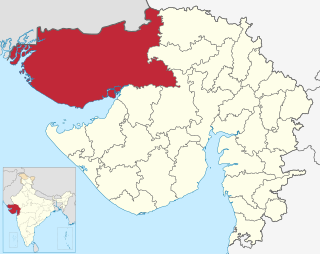Radhanpur is a city and a municipality in Patan district in the Indian state of Gujarat.

Koteshwar is a small village and the location of an ancient Shiva temple. It located near the mouth of Kori Creek, in the west of Kutch district of Gujarat, India.
Desalpar Gunthli is a village and site belonging to Indus Valley civilisation located at Nakhtrana Taluka, Kutch District, Gujarat, India. Desalpar is approx 25 km away from Bhuj. This site is of modest dimensions,(130 m by 100 m ) situated on the northern banks of once depredatory (erosive) stream, Bamu-Chela, an affluent of the Dhrud river.
Fatehgadh also called Ramgadh by locals,is a town near Rapar of Kutch district of Gujarat, India.

Kera is a village in Bhuj Taluka of Kutch district of Gujarat, India.this historical town was ruled by the jadeja's before independence in 1947. This historical town has several places of interest; the most important part of the town's history the Darbar gadh, the ruins of an old fort and Shiva temple, and the shrine of a Muslim saint Ghulam Ali.
Pipar is a village in Lakhpat Taluka of Kutch district of Gujarat, India.
Kanoj, formerly known as Ra Kanoj, was a town destroyed whose ruins are stretched for a mile. They are located in Lakhpat Taluka of Kutch district of Gujarat, India.

Sandhan is a village on the coast of Gulf of Kutch about thirty miles west of Mandvi, in Abdasa Taluka of Kutch district of Gujarat, India.
Maharajadhiraj Mirza Maharao Bharmalji II was the Rao of Cutch belonging to Rajput dynasty, who ascended the throne of Princely State of Cutch one month after the death of his father Rayadhan III.
Rao Rayadhan III was the Rao of Cutch belonging to Jadeja Rajput dynasty, who ascended the throne of Princely State of Cutch in 1778 and ruled until 1786 when he was deposed. He again ruled as titular head under council of Bar Bhayat ni Jamat from 1801 to 1813.
Rao Prithviraj ji, also known as Bhaiji Bava, was the Rao of Cutch belonging to Jadeja Rajput dynasty, who ascended the throne of Princely State of Cutch as a titular head in 1786 and ruled until 1801 when he died at the early age of twenty seven. He ruled as titular head under council of Bar Bhayat ni Jamat.

Fateh Muhammad was a regent who administered Cutch State as a leader of Bar Bhayat ni Jamat under titular kings, Prithvirajji and Rayadhan III.
Rao Godji II, was the Rao of Cutch belonging to Jadeja Rajput dynasty, who ascended the throne of Princely State of Cutch in 1760 and ruled until 1778 when he died. During his rein, the state was invaded by Kalhoras and Talpuras of Sindh several times.

Rao Lakhpatji, also known as Lakhaji, was the Rao of Cutch belonging to Jadeja Rajput dynasty, who ruled Princely State of Cutch as a regent from 1741 to 1752. Later succeeded his father Deshalji I in 1752 and ruled until his death in 1760.
Captain James MacMurdo was the first political resident of British East India Company to Cutch State. He played important role in bringing Cutch under British suzerainty.

The history of Kutch, (kachchh) a region in the extreme west of the western Indian state of Gujarat, can be traced back to prehistorical times. There are several sites related to Indus valley civilization in region and is mentioned in Hindu mythology. In historical times, Kutch is mentioned in Greek writings during Alexander. It was ruled by Menander I of Greco-Bactrian Kingdom which was overthrown by Indo-Scythians followed by Maurya Empire and Sakas. in the first century, it was under Western Satraps followed by Gupta Empire. By fifth century, Maitraka of Valabhi took over from which its close association with ruling clans of Gujarat started. Chavdas ruled the eastern and central parts by seventh century but then came under Chaulukyas by tenth century. After fall of Chaulukya, Vaghelas ruled the state. Following conquest of Sindh by Muslim rulers, Rajput Samma started moving southwards to Kutch and ruled western regions initially. By tenth century, they controlled significant area of Kutch and by thirteenth century they controlled whole of Kutch and adopted a new dynastic identity, Jadeja.

Radhanpur is a town and a municipality in Patan district in the Indian state of Gujarat. Radhanpur belonged to the Vaghelas in early years and later it was held as a fief under the Gujarat Sultanate by Fateh Khan Baloch. During Mughal period, the descendants of Babi dynasty were appointed as the governor of Radhanpur and other villages of North Gujarat. After decline of Mughal, they became free and established themselves as independent rulers. In 1743, Babi descendant Jawan Mard Khan II took over viceroyalty of Ahmedabad and controlled several villages in North Gujarat.He was defeated by vaghela Un Jagir in 1753. He was defeated by Maratha Gaekwads in 1753 at Ahmedabad and Gaekwads agreed to his demand of control of villages in North Gujarat headquartered at Radhanpur State. His descendants lost some of these villages to Gaekwads subsequently. In 1813, Sher Khan made a treaty with the Gaekwar and British and became British protectorate. His descendants ruled the state until independence of India in 1947.
Varahi is a village in Santalpur taluka of Patan district of Gujarat state of India.
Suigam is a village in Suigam Taluka of Maratha Riyasat in Gujarat, India, but it is now a Taluka of Vav-Tharad District in Gujarat.
Tervada is a village in Kankrej Taluka of Banaskantha district in Gujarat, India.

















